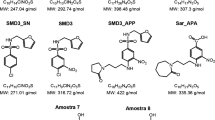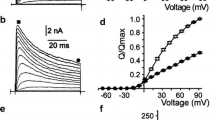Summary
Experiments were performed to compare the mechanism of block of voltage-dependent K channels by various short and long alkyl chain tetraalkylammonium (TAA) ions at internal and external sites. Current through single channels was recorded from excised membrane patches of cultured neuroblastoma cells using the patch-clamp technique. All of the TAA derivatives tested blocked the open channel when applied to either side of the membrane. Tetraethylammonium (TEA) reduced the amplitude of current through the open channel. Tetrabutylammonium (TBA) and tetrapentylammonium (TPeA) reduced the open time as a function of the concentration. An additional nonconducting state was observed when TBA or TPeA was applied internally or externally, due to the presence of a drug-bound and blocked state of the channel. The closing rate under control conditions was similar to that in the presence of external tetramethylammonium (TMA), suggesting that channel closing is independent of external drug binding. The concentration for half maximal block of the channel by external TEA was 80 μ m. The channel was less sensitive to internal TEA, which half blocked the channel at 27 mm. The dissociation rate of long alkyl chain TAA ions from the channel was slower when applied to the inside, compared to external application, suggesting the presence of distinct internal and external receptors. Long alkyl chain TAA derivatives, such as TBA had a faster association rate with the open channel when applied to the inside of the membrane than when applied to the outside.
Similar content being viewed by others
References
Armstrong, C.M. 1969. Inactivation of the potassium conductance and related phenomena caused by quaternary ammonium ion injection in squid axons. J. Gen. Physiol. 54:553–575
Armstrong, C.M. 1971. Interaction of tetraethylammonium ion derivatives with the potassium channels of giant axons. J. Gen. Physiol. 58:413–437
Armstrong, C.M., Binstock, L. 1965. Anomalous rectification in the squid giant axon injected with tetraethylammonium chloride. J. Gen. Physiol. 48:859–872
Armstrong, C.M., Hille, B. 1972. The inner quaternary ammonium ion receptor in potassium channels of the node of ranvier. J. Gen. Physiol. 59:388–400
Blatz, A.L., Magleby, K.L. 1984. Ion conductance and selectivity of single calcium-activated potassium channels in rat muscle. J. Gen. Physiol. 84:1–23
Clay, J.R. 1985a Potassium current in the squid giant axon. Int. Rev. Neurobiol. 27:363–384
Clay, J.R. 1985b Comparison of the effects of TEA+ and Cs+ on potassium current in squid giant axons. Biophys. J. 34:885–892
Davies, N.W., Spruce, A.E., Standen, N.B., Stanfield, P.R. 1989. Multiple blocking mechanisms of ATP-sensitive potassium channels of frog skeletal muscle by tetraethylammonium ions. J. Physiol. 413:31–48
DeCoursey, T.E., Im, W.B., Quandt, F.N. 1989. Externally applied tetraalkylammonium ions block open delayed rectifier K channels at both internal and external sites. Biophys. J. 55:540a
Dubois, J.M. 1983. Potassium currents in the frog node of Ranvier. Prog. in Biophys. Molec. Biol. 42:1–30
French, R.J., Shoukimas, J.J. 1981. Blockage of squid axon potassium conductance by internal tetra-N-alkylammonium ions of various sizes. Biophys. J. 34:271–291
Hartmann, H.A., Kirsch, G.E., Drewe, J.A., Taglialatela, M., Joho, R.H., Brown, A.M. 1991. Exchange of conduction pathways between two related K+ channels. Science 251:942–944
Hille, B. 1967. The selective inhibition of delayed potassium currents in nerve by tetraethylammonium ion. J. Gen. Physiol. 50:1287–1302
Kristbjarnarson, H., Arhem, P. 1982. Tetrabutylammonium affects the nodal nerve membrane from inside only. Acta Physiol. Scand. 116:303–304
MacKinnon, R., Yellen, G. 1990. Mutations affecting TEA blockade and ion permeation in voltage-activated K+ channels. Science 250:276–279
Neher, E., Steinbach, J.H. 1978. Local anesthetics block currents through single acetylcholine-activated channels. J. Physiol. 277:153–176
Quandt, F.N., Narahashi, T.N. 1984. Isolation and analysis of inward currents in neuroblastoma cells. Neuroscience 13:249–262
Quandt, F.N. 1987. Burst kinetics of sodium channels which lack fast inactivation in mouse neuroblastoma cells. J. Physiol. 392:563–585
Quandt, F.N. 1988. Three kinetically distinct potassium channels in mouse neuroblastoma cells. J. Physiol. 395:401–418
Quandt, F.N., Im, W.B. 1992. Tetraalkylammonium ion block of potassium currents in mouse neuroblastoma cells. J. Pharmacol. Exp. Ther. 260:1379–1385
Rudy, B. 1988. Diversity and ubiquity of K channels. Neurosci-Ence 25:729–749
Spruce, A.E., Standen, N.B., Stanfield, P.R. 1987. The action of external tetraethylammonium ions on unitary delayed rectifier potassium channels of frog skeletal muscle. J. Physiol. 393:467–478
Stanfield, P.R. 1983. Tetraethylammonium ions and the potassium permeability of excitable cells. Rev. Physiol., Biochem. Pharmacol. 97:1–68
Stocker, M., Stühmer, W., Wittka, R., Wang, X., Muller, R., Ferrus, A., Pongs, O. 1990. Alternative Shaker transcripts express either rapidly inactivating or noninactivating K+ channels. Proc. Natl. Acad. Sci., USA, 87:8903–8907
Stühmer, W., Ruppersberg, J.P., Schroter, K.H., Sakmann, B., Stocker, M., Giese, K.P., Perschke, A., Baumann, A., Pongs, O. 1989. Molecular basis of functional diversity of voltagegated potassium channels in mammalian brain. EMBO J. 8:3235–3244
Swenson, R.P., Jr. 1981. Inactivation of potassium current in squid axon by a variety of quaternary ammonium ions. J. Gen. Physiol. 77:255–271
vanMastright, R. 1977. Constant step approximation of multiexponential signals using a least squares criterion. Comput. Biol. Med. 7:231–247
Vergara, C., Moczydlowski, E., Latorre, R. 1984. Conduction, blockade and gating in a Ca2+-activated K+ channel incorporated into lipid bilayers. Biophys. J. 45:73–76
Villarroel, A., Alvarez, O., Oberhauser, A., Latorre, R. 1988. Probing a Ca+ activated K+ channel with quaternary ammonium ions. Pfluegers Arch. 413:118–126
Yellen, G. 1984. Ionic permeation and blockade in single Ca2+-activated K+ channels in bovine chromaffin cells. J. Gen. Physiol. 84:157–186
Yellen, G., Jurman, M.E., Abramson, T., MacKinnon, R. 1991. Mutations affecting internal TEA blockade identify the probable pore-forming region of a K+ channel. Science 251:939–942
Author information
Authors and Affiliations
Additional information
We would like to thank Karen Hynes for technical assistance, and discussions with Dr. T. DeCoursey. Thanks also to Dr. J. Hirsh and Dr. J. Yeh for comments on the manuscript. This study was supported by grant RG 2124-A-1 from the National Multiple Sclerosis Society. We wish to thank the Digital Equipment Corporation for the donation of a VAX 3500 computer system.
Rights and permissions
About this article
Cite this article
Imt, W.B., Quandt, F.N. Mechanism of asymmetric block of K channels by tetraalkylammonium ions in mouse neuroblastoma cells. J. Membarin Biol. 130, 115–124 (1992). https://doi.org/10.1007/BF00231890
Received:
Revised:
Issue Date:
DOI: https://doi.org/10.1007/BF00231890




